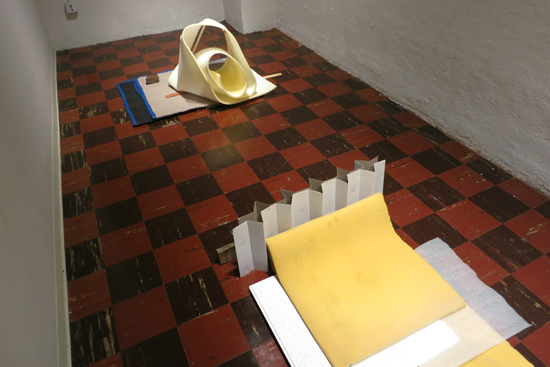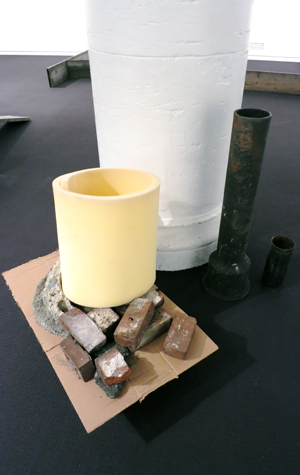Creating Art from Reclaimed Materials
BU exhibition considers how human body moves through space

Vlatka Horvat’s new exhibition at the BU Art Gallery, Also Called: Backbone, Anchor, Lifeline, was created from reclaimed objects and materials. Photos by Cydney Scott
Using reclaimed building materials, a new show at BU asks provocative questions about our notions of stability and the human body’s movement through space. Taking its cue from the Boston University Art Gallery at the Stone Gallery’s art deco railings, knobs, faux detailing, and decoration, the site-specific exhibition by Vlatka Horvat, titled Also Called: Backbone, Anchor, Lifeline, offers a series of tableaux featuring passages, barriers, and other configurations.
London-based artist Horvat, who was born in Croatia, often draws on her background in performance when creating her installations. She says she was inspired by the gallery space, formerly a car dealership, as she went about building the show. “I wanted to treat it as a territory of sorts, a landscape, a shifting and changing field populated with several temporary and makeshift structures, constellations, and arrangements of objects and materials,” says Horvat.
The installation comprises both found elements, such as cinder blocks, scaffold planks, packing foam, paper, bricks, and metal pipes, gathered from around BU, and some purchased elements. Horvat has juxtaposed flimsy and heavy materials and arranged them in the gallery in a precarious, provisional manner. Cinder blocks dot the floor like a forlorn graveyard. An unstable construction of cardboard, bricks, foam, and crusted cement stands beside a pillar. Wooden planks lie in stacks and stand on edge in constructed barriers throughout the room. Much of Horvat’s previous work has focused on this kind of reorganization and manipulation of space.

“These dynamics between verticality and horizontality, between an upward drive and a downward pull, between a sense of reach on the one hand and a feeling of a potential collapse or fall on another, were things that I was playing with when working on this installation,” the artist says.
With a master’s in performance from Northwestern University, Horvat says she is particularly interested in exploring how the human body moves and interacts within a physical space. “Many of the projects I have been developing in the past few years have to do with gestures of reorganization of space and spatial relations between bodies, objects, and elements of architecture,” she says.
Kate McNamara, BU Art Gallery director and chief curator, has closely followed Horvat’s career for several years. She says she was immediately struck by the artist’s “site-responsive and specific mode” of artistic creation. “I was initially drawn to the corporeal nature of her work—the production of experience in her photographic and performative series and later to her use of familiar, provisional, and found materials that are installed in an attempt to reference and interfere with notions of functionality,” says McNamara. “My hope is that this installation offers the community a moment of pause and reflection, as well as an inquiry about the nature of installation and modes of production. Horvat’s thoughtful, contemplative, performative, and occasionally humorous and melancholic gestures ask the viewer to navigate the space in counterintuitive ways.”
 Horvat says she hopes the installation leads viewers to rethink the world around them. “I hope they might take time to look, and look again, from different vantage points and different directions,” she says. “And that they might move around, and stand still, and that they would continue to look at things closely once they’re out of the installation—the space, how it’s organized, what is possible in it.”
Horvat says she hopes the installation leads viewers to rethink the world around them. “I hope they might take time to look, and look again, from different vantage points and different directions,” she says. “And that they might move around, and stand still, and that they would continue to look at things closely once they’re out of the installation—the space, how it’s organized, what is possible in it.”
Also Called: Backbone, Anchor, Lifeline is on display at the Boston University Art Gallery at the Stone Gallery, 855 Commonwealth Ave., through December 20. Admission and gallery events are free and open to the public; hours: Tuesday to Friday, 11 a.m. to 5 p.m., Saturday and Sunday, 1 to 5 p.m., closed Mondays and holidays. Find more information here.
Erin Thibeau can be reached at ethibeau@bu.edu; follow her on Twitter at @erinthibeau.
Comments & Discussion
Boston University moderates comments to facilitate an informed, substantive, civil conversation. Abusive, profane, self-promotional, misleading, incoherent or off-topic comments will be rejected. Moderators are staffed during regular business hours (EST) and can only accept comments written in English. Statistics or facts must include a citation or a link to the citation.